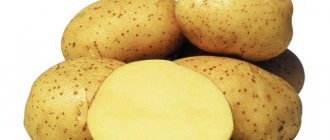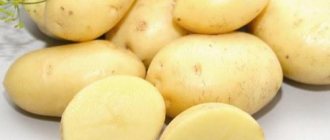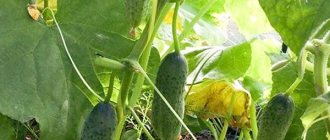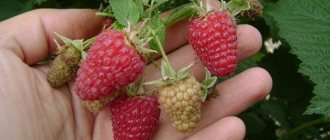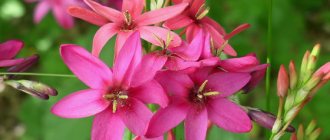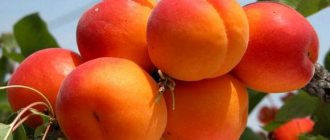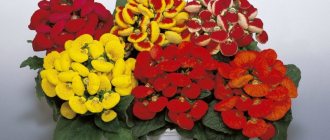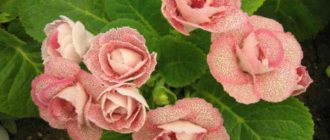Diseases and pests
Corydalis is susceptible to various pests and diseases.
Viruses can be identified by the appearance of spots and patterns on the foliage; they can also cause it to begin to curl or become covered with small growths. As soon as you notice such symptoms, immediately remove the infected individuals, since they cannot be cured, and in the future they will infect the entire flowerbed.
Fungi manifest themselves in dark spots on the foliage, and sometimes rust may appear in the form of red spots. The affected parts are cut off and burned, and the plants themselves are treated with fungicides, for example, Bordeaux mixture.
Dangerous pests are moles and mice. They gnaw the tubers, which causes rot. Rodents are destroyed by making traps in the area and filling their holes with water. The affected tubers are cut off, treated with wood ash and slightly dried.
To drive away slugs, you need to scatter crushed eggshells or lime over the area.
The bulb nematode is probably the most problematic pest of all. It attacks the tubers of the plant, leaving ring marks behind it. The foliage begins to turn yellow due to the damage.
Affected individuals are removed, and the rest are dug up and kept for up to 30 minutes in water at a temperature of 55°C. Next, the roots can be planted in another area, but where the corydalis grew before, it will not be possible to plant bulbous plants for a long time.
As you can see, when growing corydalis, a number of difficulties can arise, but, nevertheless, thanks to early flowering, high frost resistance, lack of need for fertilizers and, as a rule, rare watering, corydalis is becoming an increasingly frequent guest in our flower beds.
Description
Varieties and types of phlox description, photo
Corydalis dense is a low, very fragile plant. Once it is picked, it quickly fades. Therefore, collecting bouquets of corydalis is a futile exercise. It is one of the very first to appear in our country, along with the lungwort. The flower fades very quickly, literally in a week, that is, it is an ephemeroid. Its closest relative is the Marshall Corydalis
with white flowers. I can’t help but mention one more plant - the officinalis with very similar, but noticeably smaller flowers.
Flowers
Upd. 2021.10
The inflorescence is collected in a dense raceme, with eight or more flowers in the inflorescence. The flowers sit on long (about 10 mm) pedicels. Mostly the corydalis is visited by bumblebees; I did not see any mosquitoes or hoverflies. But many insects gnaw through the spur from behind and thereby immediately gain access to the nectar. It blooms in April-May for only a few days.
Upd. 2021.10
The corolla is bluish-violet or pinkish-violet. Hidden between the two outer petals are the two inner ones. It is interesting that the corydalis spur is raised end up. This, apparently, gave the name to the plant (the upward-pointing spur resembles a tuft).
Upd. 2021.10
Corolla from below. I just can’t get rid of the association with some kind of predator. Association with a slamming mouth. This is what the two outer petals of the corolla look like, one below and one above.
Upd. 2021.10
The bracts may be noticeably incised into 4-7 linear lobes.
Or they may have small, blunt teeth.
Upd. 2021.10
The bracts are bluish below, with translucent reddish veins. At the corolla (bottom view) no traces of a calyx or sepals are visible; the only thing that can be said is that the peduncle near the corolla barely noticeably widens.
Upd. 2021.10
Let's see the size of the flower. The corolla is approximately 1.5 cm long from the end of the spur to the edge of the outer petals of the corolla. The width of the spur at its thickest part is 2-3 mm. The bract is 7-8 mm long and 3-4 mm wide.
Leaves
Upd. 2021.10
The leaves are petiolate, almost three times pinnate (trifolate). Almost - because the terminal lobes can be either feathery (trifoliate) or notched. Segments on long petioles, cut almost to the base into linear-oblong lobes (or solid lobes with teeth at the apex). The underside of the leaves is lighter.
Upd. 2021.10
There are no stipules. The petiole is fleshy, as is the stem. There is no pubescence.
Upd. 2021.10
The leaves are alternate, usually two with long petioles.
Upd. 2021.10
The leaves are approximately the same in length and width, in my photographs they are about 5 cm. The terminal lobes of the leaves are 5-6 mm wide.
Stem
The stem of the corydalis is juicy and very fragile, so much so that it unexpectedly breaks right under your fingers. Along the stem there are brown strands or stripes, which do not give much strength to the stem. Plant height 10-25 cm.
A filmy scale extends from the stem right near the ground. This is not a leaf, but a burst shell of a sprout. Usually you don't pay attention to it, but it is nevertheless quite noticeable.
Fruit
Upd. 2021.10
The fruits have just set, the “spout” column is still visible. However, they will remain with the “nose”.
Upd. 2021.10
The fruit is a pod-shaped capsule, oblong, drooping, about a centimeter long.
Corydalis dense grows in deciduous forests, in clearings and forest edges.
Application
The plant is poisonous! Under no circumstances let children taste the whisk, the way we usually do with lungwort.
!
Caring for corydalis in the garden
How to care for a corydalis
Miscanthus description, propagation, care, planting, use in the garden, photos, varieties and types
Corydalis in open ground needs watering, loosening the soil, weeding, fertilizing and protection from diseases and pests. However, each species has its own requirements and preferences that should be taken into account when growing.
Watering and feeding corydalis
In early spring, when growth begins, the soil is usually moist from melting snow, so you won't have to water the flowers. In the future, all corydalis need regular watering, but desert and alpine species tolerate drought much more easily than stagnation of water in the roots
Actually, stagnation is unacceptable for any of the species, which is why it is so important that the soil in which the corydalis grows is well-drained
After watering, the soil around the plants is loosened and weeded, but if it is covered with organic mulch, you will have to weed, loosen, and even water the area much less often.
Only forest species of corydalis need to be fed, digging up the soil when planting with leaf humus or compost. Organic fertilizers can be used as mulch, which covers the area in the spring.
After flowering is completed, the ground organs of the corydalis gradually turn yellow and die. To remember where it grew, mark the area with pegs. Since Corydalis is highly winter-hardy, there is no need to cover it for the winter. The only exception is the Chinese corydalis, which freezes out at a temperature of -23 C.
Transplantation and propagation of corydalis
Corydalis is best replanted during the dormant period, although it easily tolerates this procedure even during flowering. However, the above-ground part of a flowering plant may break off, then the tubers will go into a dormant state. The plant is replanted while preserving the earthen coma.
Corydalis is propagated by tubers, division of rhizomes and by seed. Only Bush and Kashmir corydalis form tubers on rhizomes. The division of the rhizome is carried out during transplantation, in the second half of summer or spring. The bush is divided so that each division contains part of the rhizome and a renewal bud. The divisions are planted to a depth of 5 to 15 cm, depending on the size of the tubers, keeping a distance between holes of at least 10 cm. However, dividing the rhizome is not the most popular way of propagating corydalis.
For seed propagation, unripe seeds are used, which have already turned black, but are still in a green box. Don't miss the moment, otherwise the dried boxes will open, the seeds will fall to the ground, and the ants will take them away. Corydalis seeds lose their germination within a week, so hurry up with sowing.
Corydalis seeds are sown in containers with moist soil and germinated in the shade, preventing the substrate from drying out. Seedlings are planted in open ground next spring, and they will begin to bloom, depending on the species, in 2-4 years.
Features of care
Caring for the plant is not particularly difficult. Like all plants, the corydalis loves to be cared for. Although care is minimal, it is necessary.
The necessary conditions:
- watered as needed so that the soil does not dry out to a hard crust. Again, here we need to focus on the species and its native habitat. That is, forest species require more frequent watering, while others tolerate drought better.
- Illumination depends on their native habitats - forest ones prefer partial shade, the rest prefer open, raised sunny places.
- Fertilizing – only forest plant species are fed with organic fertilizers. Fertilizer is placed in the ground when planting, and then organic matter is added using mulch.
- After watering, the next day it is useful to carry out weeding , combining it with loosening the soil.
- For the winter, is covered and only in those regions where the winter temperature drops below -23 degrees.
Corydalis is not watered in early spring, since the ground is quite wet after the snow melts and spring rains. During this period, you can mulch old bushes with organic matter, which will also serve as fertilizer. After the plant has finished blooming, its dry shoots are cut off and the place is marked with a peg so as not to trample or dig up the tubers.
Preparing for winter
The plant is not covered for the winter. Only the Chinese corydalis is covered with spruce branches, preventing its tubers and roots from freezing.
Care problems
The leaves of the corydalis dry out and turn yellow - if this happens after flowering, the plant goes into dormancy until next spring. If this occurs before flowering, then it is chlorosis or mosaic viral spotting.
Lack of flowering is an incorrect location or lack of magnesium and potassium in the soil.
general characteristics
Lilac flower photo and variety of varieties
Butterflies are medium in size, less often large in size. Butterflies mostly have a thick and hairy body. The abdomen is elongated. The antennae of males have long combs, while those of females have short combs. The proboscis is underdeveloped; imagoes do not feed. The feet of butterflies are covered with long hairs. Fore wings, narrow, often with a hairy tooth in the middle of the rear edge. The antennae are comb-like.
Active at dusk and at night. Caterpillars of varied, often very bizarre appearance, in most species live on tree species. In Palaearctic species, the overwintering stage is the pupa, which is located in a dense, less often in a loose, cocoon, on the soil or on food plants.
There are about 3,500 species in the world fauna; 119 species live in Russia.
Corydalis dense KK Rostov region
Corydalis solida (L.) Clairv Division Angiosperms – Magnoliophyta (Angiospermae) Class Dicotyledons – Magnoliopsida Order Poppy – Papaverales Family Corydalis – Fumariaceae Rarity status category. 5. A recovering species whose numbers and distribution area are approaching a state where they will not require special conservation measures. RKR – E.
Description
Perennial tuberous grass 8–20 cm high. The tuber is spherical, 8–15 mm in diameter, light brown. There are no basal leaves. The stem bears in the lower part 1 scale-like leaf and 2 twice tripartitely dissected leaves with incised lobes. Flowers up to 2 cm long, with a spur, violet-pink, collected in multi-flowered dense apical racemes with incised or jagged bracts. Sometimes an additional inflorescence develops in the axil of the upper scale-like leaf. The capsules are pod-shaped, drooping or deflected, oblong, 10–12 mm long. and 3–4 mm wide. The seeds are round, black, smooth, shiny, with hard covers, about 2 mm in diameter, with a developed fleshy appendage - elaiosome.
Spreading
European nemoral look. Distributed in the West. and Vost. Europe, including Russia, in the belt of mixed and deciduous forests, in the forest-steppe and in the north of the steppe zone, in the West. Siberia, Mediterranean, Mal. and Wed. (introduced in the vicinity of Tashkent) Asia. – In the Rostov region. found scatteredly north of the lower Don valley.
Features of biology and ecology
Mesophyte, scioheliophyte. Lives in deciduous forests. In the region it grows in ravine forests and shrub formations derived from them, as well as in floodplain oak forests, where it often dominates in the synusia of ephemeroids. It also grows in old artificial forest plantations. Geophyte. Forest early spring ephemeroid. Entomophile (insect-pollinated plant). Myrmecochore (seeds are spread by ants). Seeds with an underdeveloped embryo. It blooms in the 4th–6th year, the duration of complete ontogenesis in nature is from 10 to 17 years. It reproduces by seeds, vegetative reproduction is observed at the end of the life cycle (senile particulation). Flowers III–IV, fruits IV–V.
Number
The condition and population size of the species depend on the area of the forest and the degree of its anthropogenic disturbance. Most populations in well-formed ravine forests are characterized by high numbers (up to hundreds of thousands of individuals or more) and density, completeness. At the southern and eastern limit of distribution (Ust-Donetsk, Oblivsky, Tsimlyansky districts) populations are small. The population status is currently stable.
Limiting factors
Drying of beams, logging in forests, anthropogenic disturbances of the habitat. Previously, it was actively eradicated (collecting bouquets for sale, digging up tubers as medicinal raw materials and for replanting in gardens). Currently, the scale of extirpation of the species has been reduced, which has allowed most populations to stabilize.
Security measures
Included in the regional list of Donetsk region. (2007). Protected in many forest protected areas: “Filkino tract” in Belokalitvinsky district, “Donetskoye tract”, “Peskovatsko-Lopatinsky forest” and “Karpov forest” in Verkhnedonsky district, “Fominskaya Dacha” in Millerovsky district, “Golden Gorki" in the Oktyabrsky district, "Vlasova Balka" and "Razdorsky Slopes" in the Ust-Donetsk district, etc. Cultivated in the nursery of Red Book plants in the Botanical Garden of the Southern Federal University; It is stable in cultivation and self-seeding.
Practical significance. Medicinal and ornamental plant. Information sources. 1. Smirnova, Cheryomushkina, 1975; 2. Gorchakovsky, Shurova, 1982; 3. Mikhailova, 2001; 4. Rare... Growth. region, 1996; 5. Shmaraeva et al., 2012. Compilers. Shishlova Zh.N., Shmaraeva A.N. Photo. Panasyuk B.A.
| 17.12.2017 18:11:45
Features of Corydalis
The flowering plant corydalis is a perennial and an annual. The rhizome of such a plant is quite massive, it is located at a fairly large depth and consists of branched shoots. On individual shoots, the formation of round-shaped tubers is sometimes observed, inside of which there are nutrients. The height of erect shoots can vary from 0.15 to 0.45 m. At the base of the stems there are 2–4 fern-like leaf plates of a dark green color with a bluish bloom. The leaves can be double or triple compound, the shape of the lobes is triangular or round, and each of them has its own petiole. The formation of racemose cylindrical inflorescences on the tops of the stems is observed in mid-April. The inflorescences include 5–35 long flowers, which can be colored pink, lilac, white, violet or yellow. The flowers have a corolla length of 1.5 to 2.5 centimeters, pointed sepals are small, and bracts are relatively large. All flowers have fairly long spurs that contain nectar. It can only be obtained by insects that have a long proboscis. The fruit is an oblong-shaped capsule, inside of which there are small glossy black seeds. Each seed has a fleshy growth that ants simply adore. As a result, ants can drag these seeds over a fairly long distance.
Corydalis begins to grow in March. Its flowering begins after the soil warms up to 3–4 degrees. Flowering duration is approximately 20 days. Seed ripening is observed in June, after which the part of the plant that is above the ground dies. In landscape design, these plants are most often grown with other primroses, for example: crocuses, muscari, chionodoxes, galanthus and early tulips.
Useful properties of corydalis
All the properties of the plant are due to the presence of many alkaloids, the most valuable of which is bulbocapnin. It is used for paralysis, trembling limb syndrome, and increased muscle tone. When ingested, it causes muscle relaxation, motor inhibition, inhibits intestinal function, and has a calming effect on the nervous system. Preparations based on grass and tubers have the following effects on the body :
- pain reliever;
- anesthetic;
- antitumor;
- anti-inflammatory;
- antioxidant;
- hemostatic;
- astringent.
Planting corydalis
After bearing fruit, the tuberous corydalis turn yellow and dry out, falling into a state of dormancy. In the soil at a shallow depth they have tubers that are practically not afraid of any danger - neither digging the soil, nor regularly mowing the lawn, nor drought or trampling. All operations for digging, transplanting and planting these plants are painlessly and conveniently performed in this state. However, during the dormant period, corydalis are not always easy to detect. Therefore, if necessary, plants can be replanted during the growing season and even during the flowering period. It is better to do this while preserving the clod of earth. It should be borne in mind that when transplanting during growth, the above-ground part easily breaks off. In this case, the plant will not die, but will go into a dormant state and continue the growing season only the next year.
Tubers that have fallen into dormancy go on sale from mid-June to September. They are packed in a perforated plastic bag with sawdust to prevent them from drying out. Tubers should be hard and juicy; flabby and wrinkled ones are not suitable for planting. Some drying is permissible only for Central Asian species. A small renewal bud is present on the upper side of a healthy tuber. Forest corydalis with small tubers are buried to a depth of 5 - 7 cm, large tubers, especially Central Asian species, are buried at 10 - 15 cm. The choice of place for growing and soil preparation depend on what plants you are going to plant.
Forest and Caucasian corydalis are kept in the same way as snowdrops. They can even coexist with each other. Hills and high ridges are suitable for Central Asian species. For drainage, crushed stone or fine gravel is placed at the base of the ridge. They can also be added to the soil to improve the drainage of excess water. If the plants feel worse from year to year or the summer was very damp, they can be dried during the dormant period for a month in a ventilated area at room temperature. You can make a greenhouse over them: shelter from rain until autumn.
7. Reproduction
There are 3 ways to propagate a flower - separating small daughter tubers, dividing the rhizome of an adult plant and sowing seeds. The choice of propagation method will depend on the specific variety.
↑ Up,
7.1.Growing corydalis from seeds
The seed method is probably the most common method for propagating this flower. Varieties such as dense corydalis, Marshall and bracts are very easily propagated by seeds and often even self-sow.
For propagation by seeds, you can use planting material collected from garden plants. When using such seeds, flowers are protected only by species and not varietal characteristics, so the appearance of the resulting bushes can be strikingly different from the mother flowers.
Full ripening of the seeds occurs in June, but you should not wait for it. From fully ripened and opened seed pods, seeds fall to the surface of the soil, from where they are quickly carried away by ants. It is worth taking care of collecting planting material at a time when they have already acquired a black color, but before the seed pods open. Also, to prevent rashes, you can pre-wrap the boxes with gauze.
↑ Up,
The planting material collected with your own hands can be sprinkled with wet sand and left to ripen at room temperature, making sure that the sand is constantly moist.
At a high level, the germination of seeds is maintained only until they begin to dry out, so sowing is carried out immediately after collection. After a week, the seeds will already lose their life-giving moisture. Wet sphagnum moss will help prolong the viability of seeds, but even in such conditions, after a month, germination will be zero.
Sowing is carried out in the summer months, using small flower greenhouses with transparent lids or individual cups. There should be drainage holes at the bottom of the containers, and the first step is to lay a moisture-wicking layer in the form of expanded clay or broken brick.
Fill the cups with soil consisting of turf and leaf humus, peat with a large amount of river sand in the composition. The seeds are sown to a depth of about 0.5 - 1 cm, covered with soil and thoroughly moistened the soil with a spray bottle.
↑ Up,
The top of the crops is covered with glass or transparent plastic to maintain high air humidity. The soil is kept evenly moist at all times, but not waterlogged. Next spring, if the rules of agricultural technology are followed, only cotyledons will hatch.
Planting seedlings in open ground is carried out in the spring, when the snow melts and the last night frosts have gone. The first buds will be decorated with corydalis grown from seeds in the 3rd - 4th year of life and often there will be only 1 - 2 flowers on each bush. In 4-5 years, flowering will become more abundant, and the first division of tubers will occur when the plants are 5-6 years old.
↑ Up,
7.2. Division of rhizomes
By dividing the rhizomes it is possible to propagate Kashmiri and Bush corydalis. Plants 3 to 5 years old are divided during transplantation. Bushes are dug out of the ground. shake off the root system from soil residues and cut into pieces.
For division, use a sharp, sterile knife. As a result of division, each part should receive its own root system with a renewal bud.
There is no need to worry if the cuttings do not have tubers - after planting for some time, these plants will be able to form new nodules.
The wound surface that appears during division is treated with charcoal powder or wood ash for drying and disinfection.
The delenki are planted in new areas and watered. Such plants should be placed in partial shade - direct sunlight immediately after dividing can cause additional stress.
↑ Up,
7.3.Separation of daughter tubers
This method of propagation is the easiest and is available for almost all varieties of flowers. The fact is that under the surface of the soil, small daughter nodules are formed annually in the corydalis and in the autumn months, during transplantation, they are separated and planted.
Sometimes it is quite difficult to detect corydalis plantings due to the fact that its leaves die off in the fall. To be sure to dig up tubers, it is enough to mark the place where the flower was or replant and divide before the leaves die.
↑ Up,
↑ Up,
Types and varieties of corydalis
Numerous corydalis can be divided according to the environmental requirements that determine the agricultural technology of the species. The most unpretentious of the perennial tuberous corydalis are forest species, which include:
- Bush Corydalis;
- Corydalis dense, or Hallera;
- smoke-leaved corydalis;
- Caucasian corydalis;
- corydalis grandiflora, or giant;
- Kuznetsov's corydalis;
- Corydalis Magadan;
- Marshall's corydalis;
- Corydalis low;
- Corydalis malcica;
- corydalis deceptive, or doubtful;
- Corydalis bractae;
- Corydalis intermedius;
- corydalis arranged, or Turchaninova;
- Corydalis angustifolia.
These species love sandy and clayey soils rich in humus and leaf humus; they can be grown in an orchard under trees, in clearings in the grass among deciduous trees and in permanent flower beds. The most popular varieties are dense corydalis, or Hallera:
- Beth Evans - a variety with soft pink flowers with a white spur;
- Prasil Strain - a variety of plants with variations in shades from red to pink and salmon;
- George Baker - a plant with bright red, almost cherry-colored flowers;
- Dieter Schacht - a variety with flowers of a soft pink hue;
- Highland Mixt - corydalis with inflorescences of a smoky bluish-pink tone;
- Munich Form - variety with coral-red flowers;
- Nettleton Pink is a plant with luscious pink flowers.
It is more difficult in our climate to grow perennials of the Himalayan deserts, foothills and highlands, which are conventionally called mountain species. These include:
- Kashmir corydalis;
- Wilson's corydalis;
- corydalis holostelum;
- Darvazian corydalis;
- Corydalis macrospur;
- Ledebour's Corydalis;
- Maracanda corydalis;
- Corydalis Narinyan;
- Pachosky's corydalis;
- Popov's corydalis;
- Corydalis dissectifolia;
- corydalis rutifolia;
- bluish corydalis;
- Severtsov's corydalis;
- Shangin's corydalis;
- Emanuel's corydalis.
Rhizomatous perennial species include yellow corydalis, sulfur yellow and noble corydalis.
Annual corydalis, such as evergreen corydalis and impatiens corydalis, are not often found in cultivation.
Recently, highly decorative corydalis from the Chinese region of Sichuan - sinuous and tall - were introduced into European garden culture. The most popular varieties of Corydalis tortuous:
- Blue Panda is a plant with pale blue-green leaves and azure flowers with curved spurs;
- Purple Leaf is a corydalis with reddish-purple foliage and stems with dark red spots at the base of the leaves;
- China Blue is a variety with brownish-green leaves in winter. The flowers are greenish-azure, up to 31 cm long;
- Balang Mist is a variety with pale blue flowers.
After this article they usually read
Add a comment
Caring for corydalis in the garden
When growing corydalis in the garden, it should be watered, weeded, fed, loosened the soil surface in a timely manner and protected from pests and diseases. But it should be noted that different species may have different requirements and preferences for care.
How to feed and water
In the first weeks of spring, when the corydalis begins to grow, as a rule, the soil is quite moist from melt water, so the plants will not need watering. After the soil dries out, the plants will need to be watered systematically. It should be noted that alpine and desert species should be provided with moderate watering, as they react negatively to stagnation of moisture in the root system, while a short drought causes much less harm to the plant. It must be remembered that any type of corydalis reacts extremely negatively to stagnation of water in the ground; therefore, the soil on the site must be well-drained. When the bushes are watered, you need to loosen the surface of the area, while removing the weeds. To reduce the number of weeding, watering and loosening, the surface of the area must be covered with a layer of organic mulch.
Only forest species of corydalis need feeding, and compost or leaf humus should be added to the soil during digging before planting. Also in spring, you can mulch the surface of the area with organic matter.
After the bushes fade, their parts located above the ground become yellow over time, and they die off. To remember where they grew, you need to mark each bush by sticking a peg next to it. This crop is quite resistant to frost, so it does not need shelter for the winter. However, it should be taken into account that the Chinese corydalis may die if the air temperature drops below minus 23 degrees.
How to replant and propagate
It is recommended to transplant this primrose during its dormant period. But even during the flowering period, corydalis bushes tolerate this procedure quite well. However, when transplanting, part of the flowering bush located above the ground can come off quite easily, in which case the tubers will begin a dormant period earlier than usual. They move the bushes to a new place along with a lump of earth.
To propagate such a plant, seeds, tubers, and also a method of dividing the rhizome are used. On rhizomes, tubers are formed only on the Kashmir and Bush corydalis. The rhizome can be divided in spring, as well as from mid to late summer, and this is done during plant transplantation. When dividing the bush, it should be taken into account that each division must have a renewal bud and part of the rhizome. When planting cuttings, they are buried 5–15 centimeters into the soil (depending on the size of the tubers), while a distance of at least 10 centimeters should be maintained between the holes. But you should also take into account that this method of propagation is not very popular among gardeners.
Unripe corydalis seeds should be sown. So, they should be painted black, but the boxes should still be green. Try to pick the boxes in time, otherwise, when they are fully ripe and open, the seeds will spill out onto the surface of the area, where the ants will quickly drag them away. The seeds remain viable for 7 days, so there is no need to delay sowing them. Seeds are sown in containers that must be filled with moistened substrate. Then they are transferred to a shaded place and make sure that the soil mixture is always slightly moist. Seedlings can be planted in the garden after spring arrives. Corydalis grown from seeds bloom for the first time after 2–4 years (depending on the species).
Diseases and pests
Corydalis are highly resistant to disease, so they rarely get sick. If there is stagnation of water in the root system, this can cause the development of a fungal disease.
Any crop can become infected with a viral disease, and it doesn’t matter whether you take good or bad care of it. Bushes affected by this disease should be removed from the soil and destroyed, and the area where they were grown should be spilled with a solution of potassium manganese, which should be strong enough
To cure a plant affected by a fungal disease, it must be sprayed with a fungicide solution.
Of the pests, mice and moles are dangerous to the corydalis. To get rid of them, it is necessary to place baits with poison on the surface of the area in several places.
Chemical composition and properties
Corydalis is rich in: phytoncides, coumarins, tannins, vitamin C and alkaloids - bulbocapnin, coridine, sanguinarine, etc. Corydalis has: anti-inflammatory, analgesic, anesthetic, hemostatic, astringent, antimicrobial, fungicidal, antioxidant, antitumor and sedative effects. In folk medicine, corydalis is recommended for:
- headache;
- high blood pressure;
- diseases of the stomach and intestines;
- internal bleeding;
- menstrual irregularities;
- diseases of the female genital area;
- liver cirrhosis;
- nervous disorders;
- paralysis;
- increased muscle tone;
- convulsions;
- Tourette's syndrome;
- Parkinson's disease;
- insomnia;
- increased excitability;
- muscle pain;
- arthrosis, arthritis;
- bruises, fractures;
- oncology;
- furunculosis, pyoderma, wounds.
- 12 tsp crushed corydalis tubers;
- 500 ml boiling water.
Pour boiling water over the tubers and let it brew for an hour. Strain the resulting infusion. Divide the infusion into three parts and take three times during the day. This infusion is recommended for colitis and female diseases. Infusion for diseases of the joints and nerves:
- 1 tbsp. crushed corydalis tubers;
- 1 tbsp. boiling water
Pour boiling water over the tubers, let sit until cool and strain. Take 1 tablespoon three times a day for arthrosis, paralysis, Parkinson's disease, muscle pain, tremors.
- 2 tsp chopped dry corydalis tuber;
- 1 tbsp. hot water.
Grind the corydalis root into dust and stir in hot water. Drink a glass of this suspension twice a day - morning and evening - for disorders of the nervous system, pyoderma, furunculosis, internal bleeding. When the condition improves, you need to take the suspension once a day - in the evening. Decoction:
- 1 tbsp. crushed corydalis tubers;
- 1 tbsp. hot water.
Pour water over the corydalis and boil over low heat for 5 minutes. Then remove the broth from the heat and let it brew for an hour. Strain. Take 1-2 tablespoons three times a day. Tincture:
- 20 g of chopped fresh corydalis root;
- 200 ml alcohol.
Fill the corydalis with alcohol and let it brew for 10 days. Strain the resulting tincture. Take 10-20 drops, diluted in half a glass of water, three times a day. For fractures, wounds, bruises, lotions are prepared from a decoction of dried leaves of Severtsov's corydalis to the affected areas. For insomnia, take corydalis root powder before bed - 0.1 grams before bed. The powder is also recommended for menstrual irregularities.
Read also: Instructions for trimming wings
Corydalis grandiflora
Growing conditions are the same as for snowdrops. Tuberous corydalis are ephemeroids. They prefer to run away from troubles rather than fight them. Corydalis inhabit a wide variety of habitats, and their reasons for fleeing are different. Forest species take advantage of the lightest period in the life of the forest, when the trees have not yet blossomed, and then fall into dormancy, unable to function under the dense canopy of branches. Corydalis from arid areas hide from the summer drought. Alpine and tundra
Corydalis live in a common rhythm with other plants in these places. Everyone is in a hurry here, because spring comes late, summer weather is unstable, and winter can come at the end of summer. Everyone is in a hurry as best they can, and corydalis with other ephemeroids are leading in this race.
However, having a similar rhythm of life, corydalis differ greatly in their requirements for living conditions. Sufficient, but not stagnant, moisture is necessary for all species during the period of active growth, in April - early May, but during the dormant period (from mid-June) everyone requires what they are used to. Forest, tundra and alpine species do not tolerate drought; species of Central Asian deserts and low mountains, on the contrary, need drying and suffer in wet soil. Forest species do not need bright sunlight; they feel better in partial shade, but species in arid habitats do not tolerate shade. Arctic corydalis and species from the highlands of Southeast Asia (for example, Kashmir) especially need good lighting. Their tastes are also varied in relation to the composition of the soil. Loose, organic-rich soils are necessary for forest species; heavy clay soils, combined with good drainage, are quite suitable for “Asians,” both low-mountain and alpine.
9.Use of corydalis in landscape design
Corydalis began to be used by flower growers quite recently - in the 19th century. Interestingly, each corydalis seed, like most spring primrose seeds, has a small fleshy sprout. This sprout is used by the plant for reproduction - ants love to eat it. Finding ripened seeds scattered on the ground, insects can take them away over considerable distances.
When grown in the garden, corydalis can become a bright accent in any flower garden, flower bed or alpine hill. Other primroses - snowdrops, crocuses, tulips - can highlight the beauty of the flower. The flower forms its buds when there is still little vegetation on the bare ground, and even less flowers.
↑ Up,
Planting corydalis in open ground
What time to plant
As a rule, corydalis planting material is sold at a time when its tubers are dormant, more precisely, from the second half of June to September. It is during this period of time that it is recommended to plant this crop in open soil. Purchased planting material must be thoroughly inspected. You should choose dense and juicy tubers. The tubers of Central Asian species of this plant may be slightly dried out, but this does not harm them.
When choosing a site for planting, you should pay attention to which group the type of corydalis you are growing belongs to. So, for example, experts advise growing Chinese, mountain and alpine species in an open, illuminated area, with well-drained sandy loam soil, and it should be located on a hill or hill
Forest species are recommended to be planted in a shaded area with loose humus soil. It must be neutral or slightly acidic.
Landing rules
There is nothing complicated about planting and growing corydalis. Before planting, the area needs to be prepared. If the soil is dense and excessively heavy, then during digging it is necessary to add fine gravel or crushed stone. It should be remembered that when moisture stagnates in the soil, rot will very quickly form on the roots. To avoid this, care should be taken to ensure that excess liquid drains from the area quickly enough.
The depth at which tubers should be planted directly depends on their size. Large tubers should be planted to a depth of 10 to 15 centimeters, and small ones should be buried 5–7 centimeters. Planted tubers need abundant watering.
Choosing a site for planting and preparing the soil
The location for planting planting material depends on the type of plant. Thus, Chinese, alpine and mountain species that prefer sunlight are planted in open areas with well-drained soil, as they do not like stagnant water. Therefore, they are planted in raised beds in an open, sunny place. All forest species prefer to grow in the partial shade of trees with nutritious and at the same time loose soil. The acidity of the soil should be neutral with a slightly acidic reaction.
IMPORTANT! The right location is the key to good growth of corydalis seedlings.
